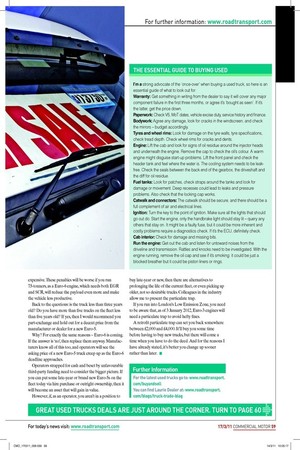THE ESSENTIAL GUIDE TO BUYING USED
Page 48

If you've noticed an error in this article please click here to report it so we can fix it.
I’m a strong advocate of the ‘once-over’ when buying a used truck, so here is an essential guide of what to look out for: Warranty: Get something in writing from the dealer to say it will cover any major component failure in the first three months, or agree it’s ‘bought as seen’. If it’s the latter, get the price down.
Paperwork: Check V5, MoT dates, vehicle excise duty, service history and finance. Bodywork: Agree any damage, look for cracks in the windscreen, and check the mirrors – budget accordingly.
Tyres and wheel rims: Look for damage on the tyre walls, tyre specifications, check tread depth. Check wheel rims for cracks and dents.
Engine: Lift the cab and look for signs of oil residue around the injector heads and underneath the engine. Remove the cap to check the oil’s colour. A warm engine might disguise start-up problems. Lift the front panel and check the header tank and feel where the water is. The cooling system needs to be leakfree. Check the seals between the back end of the gearbox, the driveshaft and the diff for oil residue.
Fuel tanks: Look for patches, check straps around the tanks and look for damage or movement. Deep recesses could lead to leaks and pressure problems. Also check that the locking cap works.
Catwalk and connectors: The catwalk should be secure, and there should be a full complement of air and electrical lines.
Ignition: Turn the key to the point of ignition. Make sure all the lights that should go out do. Start the engine, only the handbrake light should stay lit – query any others that stay on. It might be a faulty fuse, but it could be more inherent and costly problems require a diagnostics check. If it’s the ECU, definitely check. Cab interior: Check for damage and missing bits.
Run the engine: Get out the cab and listen for untoward noises from the driveline and transmission. Rattles and knocks need to be investigated. With the engine running, remove the oil cap and see if it’s smoking: it could be just a blocked breather but it could be piston liners or rings.


















































